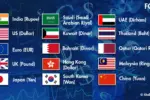The China Global Investment Tracker for 2020 is not very informative. It may not be informative because Chinese firms curbed the public disclosure of outbound investment and construction that the tracker uses.
Or it may not be informative because firms curbed their actual investment and construction, and there’s less to say.
The Chinese government insists the impact of COVID-19 has been minor, but a peek beneath their headline numbers shows this is not credible. The pandemic had a dramatic effect on transparency or, more likely, activity.
The China Global Investment Tracker (CGIT) from the American Enterprise Institute and Heritage Foundation is the most complete public record of China’s investment and construction worldwide.
More than 3,500 transactions recorded from 2005 through 2020 are accessible in a public dataset.1 The CGIT approximated official Chinese outbound investment data starting in 2005 and extending into 2019 while providing superior bilateral and sectoral figures.
Both the CGIT and official accounts show the fade in the People’s Republic of China’s (PRC) global activity predates COVID-19.
A Chinese presence is a luxury in rich countries, but most BRI participants need help with necessities—electricity and roads. As soon as health conditions permit, their demand will renew large-scale activity on the ground.
Investment started to dip in 2017, and construction flattened out about the same time. Unsustainable capital outflow and drops in the PRC’s foreign currency reserves cut into necessary financing.
A subsequent blow came from foreign doubts about the net benefits of Chinese investment.
During 2019, the CGIT and government stories started to diverge, the former showing a larger investment decline. The divergence expands sharply when COVID-19 hits.
The CGIT has flaws, starting with exclusion of smaller deals. But no regional or national investment monitor shows the stability Beijing insists on.4
For 2020, the CGIT shows investment collapsing, a two-thirds drop to barely over $30 billion. This is an artificially depressed state; numbers will soar when COVID-19 vaccination becomes widespread.
Within the paltry total, France and Chile led, both on the strength of one large transaction. Belt and Road Initiative (BRI) countries drew a larger share of investment.
Energy and transport led among sectors, with entertainment making a comeback thanks to Tencent’s acquisition of a stake in Universal.
Investment involves ownership and an indefinite presence in a host country. It is often conflated with construction of dams, highways, and the like.
The PRC’s construction and associated lending can stretch years, but they are not indefinite and do not bring asset ownership.
The average transaction is smaller than the average investment, but since 2005, there are more construction contracts at the $95 million level or higher than investments this size.
Last year, volume fell by more than half to $34 billion, though construction contracts take time to be fully confirmed, so the 2020 total will climb.
For the US, Chinese construction has never been important. Now Chinese investment is also unimportant. At its 2016 peak, the PRC’s investment in the US topped $50 billion, but some acquisitions then unraveled.
As always, energy and transport dominated. State-owned enterprises (SOEs) are responsible for nearly all construction.
Since its inception in late 2013, the BRI has accounted for the huge bulk of construction. While it is vaguely defined, 143 countries are listed on the official site.
Despite the intense blow from COVID-19 last year, BRI countries saw $440 billion in Chinese construction from 2014 through 2020.
A Chinese presence is a luxury in rich countries, but most BRI participants need help with necessities—electricity and roads. As soon as health conditions permit, their demand will renew large-scale activity on the ground.
For the US, Chinese construction has never been important. Now Chinese investment is also unimportant. At its 2016 peak, the PRC’s investment in the US topped $50 billion, but some acquisitions then unraveled.
In 2019–20 combined, investment was short of $5 billion.
PRC entities can acquire advanced American technology, which should not be permitted. But there’s been no rush of predatory spending during the pandemic.
Policymakers should turn to technology lost through exports and soaring American portfolio investment in China.
The latter can support Chinese technology and is in the many hundreds of billions of dollars when routing through the Caymans is included. Export control reform passed in summer 2018 has been largely stalled on illegitimate grounds.7 American policy needs more transparency and enforcement.
(Derek M. Scissors is a resident scholar at the American Enterprise Institute (AEI), where he focuses on the Chinese and Indian economies and on US economic relations with Asia)
Copyright: American Enterprise Institute









Comment